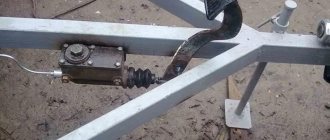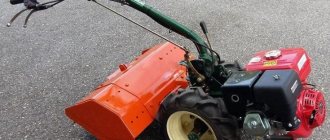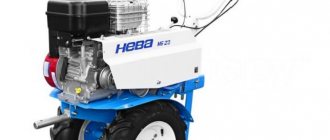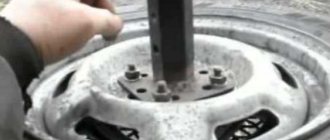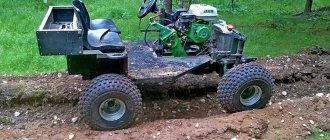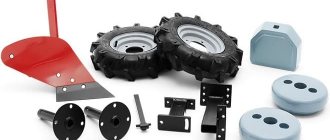A trolley for a walk-behind tractor, even one equipped with a 5-7 hp motor, for example, Neva, not to mention more powerful models, is not just a necessary thing, but an irreplaceable one in the household. Such a towed device allows you to use the walk-behind tractor not only for agricultural work, but also as a vehicle. According to statistics, owners of walk-behind tractors first of all equip their two-wheeled friends with a cultivator, hiller and trolley, and only then they begin to slowly purchase or make other mounted and trailed equipment with their own hands.
Main characteristics of trailed trolleys for the Neva
At different times, 4 trailer models were developed directly for Neva walk-behind tractors:
- Single-axle dump truck with dimensions 110x90 cm and side height - 35 cm. Load capacity -250 kg, dead weight -56 kg;
- Biaxial trolley chassis with dimensions 110x90 cm and side height - 35 cm. Load capacity - 500 kg, dead weight - 40 kg;
- TPM trolley with dimensions 133x110 cm and side height – 30 cm. Load capacity – up to 250 kg, dead weight – 110 kg;
- TPM-M trolley with dimensions 140x82.5 cm and side height - 25 cm. Load capacity - only up to 150 kg, dead weight - 85 kg.
However, this does not mean at all that only these 4 carts can be attached to the Neva walk-behind tractor. The vast majority of modern trailers are equipped with a universal hitch that allows you to attach them to any self-propelled mechanism, so you can safely take any one you like. But still, before buying another brand of trailer, it is better to first make sure that the hitch on it is suitable for your model of two-wheeled assistant.
Platform manufacturing
When making a trailer for a walk-behind tractor, it is necessary to arrange the grid, which involves fastening the traverses and crossbars relative to the side members in such a way that minor releases are ensured. Ultimately, longitudinal pipes will have to be attached to them using a welding machine. Four racks are fixed to the latter in the same way, but to their upper part it is necessary to strengthen the strappings made from a corner with a size of 25x25 mm by welding.
Basic rules for choosing a trolley for the Neva walk-behind tractor
Trailers for walk-behind tractors, be it Centaur, AGRO, Neva MB2 or Motor Sich, are not designed for movement on busy roads, not to mention highways. Their main purpose is to transport goods from vegetable gardens and summer cottages, while it is better to move them outside the road network so as not to create an emergency situation on the roads.
When choosing a trailer for a Neva walk-behind tractor, as for any other brand, you need to correctly correlate the trailer’s carrying capacity and the power of your mechanical worker. If we talk about choosing a trolley for the Neva walk-behind tractor, then, with the exception of the model range of heavy MB-23 models, the entire remaining line of models is equipped with engines from 5.5 to 7.5 hp. Therefore, the optimal solution for them would be to choose a tow hitch with a carrying capacity of 250 to 500 kg. The towbar for the Neva MB 23 walk-behind tractor can be taken with a lifting capacity of up to 1 ton. These powerful mechanisms are strong enough to pull such a load.
The remaining rules when choosing a trailed cart for any walk-behind tractor, incl. and for Neva they are dictated not so much by concern for the walk-behind tractor, but by common sense and ease of use. When choosing, you need to pay attention to:
- Body material. It is better to choose a cart whose body is made of galvanized steel - it is not afraid of frost, heat, rain or dirt.
- The presence of folding sides and tipper body tipping to make loading and unloading the cart easier and more convenient.
- Availability and quality of brakes. Since you often have to transport loads with a walk-behind tractor on uneven terrain, having reliable brakes on a steep descent will save you from major troubles.
By following these simple rules, you can choose a trailer for the Neva walk-behind tractor that will serve you for many years. But if for some reason you don’t want to buy a factory trailer, then it’s easy to make it yourself. The main thing is to find good drawings of a homemade trailer hitch and acquire the necessary tools and materials for this. But this is another topic for discussion.
Tips for carrying out work
Initially, it is necessary to deal with the frame of the structure, which is a complete system. The latter will have to be placed on the frame grid. To make it, you need to make a couple of traverses, but you need to use a corner whose dimensions are 25x25 mm. These elements will act as rear and front cross members. It is also necessary to make spars, during which a pipe with parameters equivalent to 60x30 mm is used.
It is recommended that all these parts be mated together using five crossbars. This must be done in such a way that the end result is a lattice. Such a simple design is quite easy to implement, in addition, it will have folding sides.
How to make a trailer for a walk-behind tractor with your own hands?
By design, bodies are divided into:
- Solid. The peculiarity of their design is the tight, fixed connection between the bottom and walls.
- Body with folding sides. A special feature of this device is the ability to transport large-sized cargo.
- Dump body. This body will cope with unloading work perfectly.
Preparation of a drawing of a trailer for a walk-behind tractor
What size should a homemade trailer for a walk-behind tractor be:
- If you have a light type of walk-behind tractor, then the width of the trailer should be 1 m, and the length should be 0.85 - 1.15 m. The load capacity of such a trailer is about 300 kg.
- If you have a walk-behind tractor with a power higher than 5 hp. s., then the following dimensions will be: width - 1 m, length - 1.4 - 1.5 m.
- For heavy units, a trailer with a width of 1.2 m and a length of 2 - 3 m is suitable. They are often biaxial.
Next, you need to create your own drawings and select the dimensions of the trailer you need. Only its precise design will allow you to successfully create a structure that will serve for many years. Here is an example of a drawing of such a body.
Body frame drawing
How to make a trailer for a walk-behind tractor with your own hands - assembly steps
- For a regular frame we only need 2 tubes and wheels on bearings. We can directly attach the body itself to the finished frame. In order to soften the shaking on potholes, you just need to install a spring.
- We assemble a homemade walk-behind trailer. To begin with, an additional one is attached to the main pipe, which will act as an axis. Then, on the other side, a hitch for the walk-behind tractor trailer is mounted. We weld hubs to the ends of the axial tube. Next, we secure the wheels and secure the parking stop. We attach the body, fenders and seat.
- The body is best made of wood or metal.
- Particular attention should be paid to the trailer hub; it must be strong and reliable.
How to make brakes on a trailer for a walk-behind tractor?
In order to install homemade brakes on the body and ensure a safe ride on a walk-behind tractor, you should acquire several parts for its design:
- Brake pads from a motorcycle.
- Motorcycle brake drum.
- Spokes from a motorcycle wheel.
- It is better to install the brake on both wheels. This will allow the equipment to effectively brake.
Stages of work:
- We remove the rods and cables from the disk and clean it.
- We put machined drums on the hubs and secure them at the back.
- The free space that has formed between the ribs of the drums must be wrapped with metal wire.
- We place the collapsible disk on the axle and secure it with bushings.
- We weld a piece of metal onto the axle to prevent the disc from moving.
- We mount the cables on the drums and pull them to the control.
- The control system may be a lever with a gear.
In principle, having a good diagram with accurate calculations, you can easily design both a single-axle and a two-axle dump body yourself. The main thing is to know how to do it and follow all instructions. By making this equipment yourself, you will find an incredible assistant for working on sites.
Making the simplest trailer model
If you do not want to spend a lot of effort making a trailer for a walk-behind tractor, then you can use the simplest instructions presented below to carry out the work. Thus, for manufacturing it is necessary to prepare metal pipes with the following dimensions: 60x30 and 25x25 mm. You will also need springs and wheels, which can be borrowed from a Moskvich car. Be sure to prepare a duralumin sheet, the thickness of which should be 2 mm. The master must also take care of the availability of a cut of sheet material, the thickness of which is 0.8 mm.
There is no way to make a trailer for a walk-behind tractor without using channel No. 5; in addition, fasteners will also come in handy, but among the tools we can highlight:
- electric jigsaw;
- welding machine;
- screwdriver;
- Bulgarian
Preparatory work
First of all, you need to think about what size the trailer should be so that it fits a specific walk-behind tractor and is convenient to use. After this, you will need to sketch out a drawing or sketch of the cart, on which you will display the structure from different angles, put down all the dimensions and draw the nodes.
Trailer mechanisms
You need to think through everything down to the smallest detail so that no difficulties arise during assembly of the equipment. To do this you need to understand:
- non-separable units and parts will be connected by screwing, riveting or welding;
- how the axles, bearings, bushings, hinges will be connected;
- which seat is better to install (simple or rotating);
- what to make the stand for the parking leg from;
- do you need a tipping body, to which you will have to add a mechanical tipper or a self-resetting unit with a special handle;
- which connection unit to the walk-behind tractor to choose (on bearings, bushings or hinged).
Having dealt with all these issues, you can begin to prepare a list of necessary materials and calculate the approximate cost of the future trailer.
Making flaps
In order to make homemade trailers for walk-behind tractors that will have folding sides, the installation frame must be made separately from the frame. Duralumin sheet will need to be used when finishing the platform grille, but it is recommended to fasten it using bolts. In order to finish the sides, it is permissible to use not so thick steel sheets. Fastening is carried out on strappings and racks using a welding machine.
In order to obtain a beam when making homemade trailers for walk-behind tractors, it is necessary to use two channels, which must be equal in length. They need to be inserted into each other, adding wheel axles to one of the ends of the structure. The finished beam must be coupled with the spars using springs. To do this, the ends of the springs should be placed on the axis of the bracket. The axis of the earring, as far as the central area is concerned, must be welded to the beam using stepladders.
The final stage of production
When working on the drawbar, it is necessary to use rectangular pipes whose dimensions are 60x30 mm. In order to obtain a two-beam design, the front ends of the pipes must first be mated and then strengthened by welding to the base of the towing device of the equipment. Then you can proceed to the rear ends of the pipes, which must be attached by welding to the front ends of the side members, while ensuring an overlap of 200 mm. At this point we can assume that the trailer is ready. If there is a need and desire, the design can be supplemented with brake lights, side lights, and turn signals.




